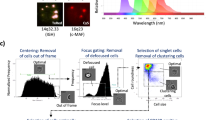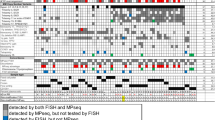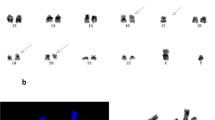Abstract
The t(6;9)(p23;q34)-DEK/CAN fusion occurs with an incidence of 1–5% in adult patients with acute myelogenous leukemia (AML) and tends to have an unfavorable prognosis at diagnosis. Due to the subtle appearance of this chromosome rearrangement, both initial detection and minimal residual disease (MRD) tracking by conventional karyotyping can be difficult. Unfortunately, no commercial or previously published fluorescence in situ hybridization (FISH) strategies exist for this recurrent anomaly. We have developed a highly sensitive assay using dual-color, double-fusion FISH (D-FISH), which can be used both for initial detection and MRD monitoring. We analyzed archived bone marrow samples from 15 patients with a previously identified t(6;9)(p23;q34) and 10 corresponding post-treatment samples. The results demonstrate that our D-FISH method effectively identified all abnormal samples, including a low-level MRD sample that was considered to be normal by conventional cytogenetic analysis. Normal value ranges were established from 30 negative controls to be <0.6% when 500 interphase nuclei were analyzed. The development of this sensitive D-FISH strategy for the detection of the t(6;9)(p23;q34) adds to the AML FISH testing repertoire, and is effective in the detection of low-level disease in post-treatment samples in these patients.
This is a preview of subscription content, access via your institution
Access options
Subscribe to this journal
Receive 12 print issues and online access
$259.00 per year
only $21.58 per issue
Buy this article
- Purchase on Springer Link
- Instant access to full article PDF
Prices may be subject to local taxes which are calculated during checkout




Similar content being viewed by others
References
Jaffe ES, Harris NL, Stein H, Vardiman JW . World Health Organization Classification of Tumours: Pathology & Genetics of Tumours of Haematopoietic and Lymphoid Tissues. Lyon, France: International Agency for Research on Cancer, 2001, pp 75–107.
Soekarman D, von Lindern M, Daenen S, de Jong B, Fonatsch C, Heinze B et al. The translocation (6;9)(p23;q34) shows consistent rearrangement of two genes and defines a myeloproliferative disorder with specific clinical features. Blood 1992; 79: 2990–2997.
von Lindern M, Poustka A, Lerach H, Grosveld G . The (6;9) chromosome translocation, associated with a specific subtype of acute nonlymphocytic leukemia, leads to aberrant transcription of a target gene on 9q34. Mol Cell Biol 1990; 10: 4016–4026.
von Lindern M, Fornerod M, van Baal S, Jaegle M, de Wit T, Buijs A et al. The translocation (6;9), associated with a specific subtype of acute myeloid leukemia, results in the fusion of two genes, dek and can, and the expression of a chimeric, leukemia-specific dek–can mRNA. Mol Cell Biol 1992; 12: 1687–1697.
Heim S, Kristoffersson U, Mandahl N, Mitelman F, Bekassy AN, Garwicz S et al. High resolution banding analysis of the reciprocal translocation t(6;9) in acute nonlymphocytic leukemia. Cancer Genet Cytogenet 1986; 22: 195–201.
Soekarman D, von Lindern M, van der Plas DC, Selleri L, Bartram CRI, Martiat P et al. Dek–Can rearrangement in translocation (6;9)(p23;q34). Leukemia 1992; 6: 489–494.
Fornerod M, Boer J, van Baal S, Morreau H, Grosveld G . Interaction of cellular proteins with the leukemia specific fusion proteins DEK–CAN and SET–CAN and their normal counterpart, the nucleoporin CAN. Oncogene 1996; 13: 1801–1808.
Hamaguchi H, Nagata K, Yamamoto K, Fujikawa I, Kobayashi M, Eguchi M . Establishment of a novel human myeloid leukaemia cell line (FKH-1) with t(6;9)(p23;q34) and the expression of dek–can chimaeric transcript. Br J. Haematol 1998; 102: 1249–1256.
Boer J, Mahmoud H, Raimondi S, Grosveld G, Krance R . Loss of the DEK–CAN fusion transcript in a child with t(6;9) acute myeloid leukemia following chemotherapy and allogeneic bone marrow transplantation. Leukemia 1997; 11: 299–300.
Dewald GW, Wyatt WA, Juneau AL, Carlson RO, Zinsmeister AR, Jalal SM et al. Highly sensitive fluorescence in situ hybridization method to detect double BCR/ABL fusion and monitor response to therapy in chronic myeloid leukemia. Blood 1998; 91: 3357–3365.
Spurbeck JL, Carlson RO, Allen JE, Dewald GW . Culturing and robotic harvesting of bone marrow, lymph nodes, peripheral blood, fibroblasts, and solid tumors with in situ techniques. Cancer Genet Cytogenet 1988; 32: 59–66.
Pardanani A, Ketterling RP, Brockman SR, Flynn HC, Paternoster SF, Shearer BM et al. CHIC2 deletion, a surrogate for FIP1L1–PDGFRA fusion, occurs in systemic mastocytosis associated with eosinophilia and predicts response to imatinib mesylate therapy. Blood 2003; 102: 3093–3096.
Brockman SR, Paternoster SF, Ketterling RP, Dewald GW . New highly sensitive fluorescence in situ hybridization method to detect PML/RARA fusion in acute promyelocytic leukemia. Cancer Genet Cytogenet 2003; 145: 144–151.
Fan YS (ed). Methods in Molecular Biology. Totowa, NJ: Humana Press Inc., 2002; 204: 334–338.
Smoley SA, Brockman SR, Paternoster SF, Meyer RG, Dewald GW . A novel tricolor, dual-fusion fluorescence in situ hybridization method to detect BCR/ABL fusion in cells with t(9;22)(q34;q11.2) associated with deletion of DNA on the derivative chromosome 9 in chronic myelocytic leukemia. Cancer Genet Cytogenet 2004; 148: 1–6.
Sinclair PB, Nacheva EP, Leversha M, Telford N, Chang J, Reid A et al. Large deletions at the t(9;22) breakpoint are common and may identify a poor-prognosis subgroup of patients with chronic myeloid leukemia. Blood 2000; 95: 738–744.
Kolomietz E, Al-Maghrabi J, Brennan S, Karaskova J, Minkin S, Lipton J et al. Primary chromosomal rearrangements of leukemia are frequently accompanied by extensive submicroscopic deletions and may lead to altered prognosis. Blood 2001; 97: 3581–3588.
Godon C, Proffitt J, Dastugue N, Lafage-Pochitaloff M, Mozziconacci M-J, Talmant P et al. Large deletions 5′ to the ETO breakpoint are recurrent events in patients with t(8;21) acute myeloid leukemia. Leukemia 2002; 16: 1752–1754.
Wang YL, Bagg A, Pear W, Nowell PC, Hess JL . Chronic myelogenous leukemia: laboratory diagnosis and monitoring. Genes Chromos Cancer 2001; 32: 97–111.
Author information
Authors and Affiliations
Corresponding author
Rights and permissions
About this article
Cite this article
Shearer, B., Knudson, R., Flynn, H. et al. Development of a D-FISH method to detect DEK/CAN fusion resulting from t(6;9)(p23;q34) in patients with acute myelogenous leukemia. Leukemia 19, 126–131 (2005). https://doi.org/10.1038/sj.leu.2403557
Received:
Accepted:
Published:
Issue Date:
DOI: https://doi.org/10.1038/sj.leu.2403557



